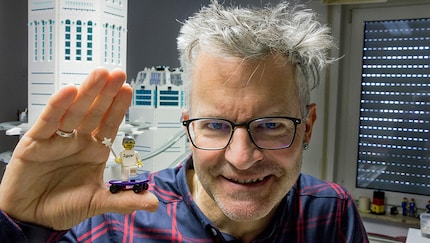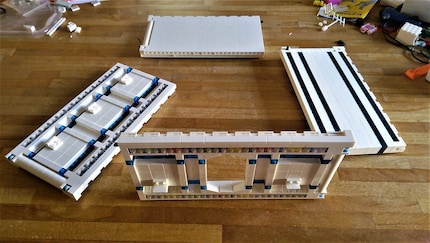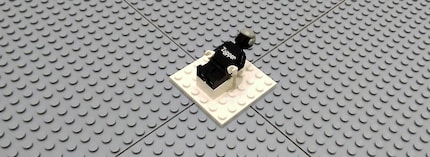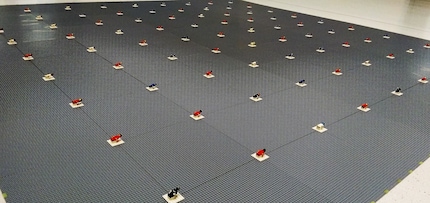
Background information
Lego fans can look forward to three exciting games with the colourful blocks
by Michelle Brändle

He doesn't have a heart of bricks, but he does have a heart for bricks: Andreas Reikowski is a convinced AFOL, an "Adult Fan of Lego". However, the 57-year-old from Stuttgart in Swabia prefers to call himself a "Lego artist" and is known as "Zypper" in the German Lego scene.
He uses commercially available plastic pieces to put together impressive structures, which he shows at exhibitions - all of which are the product of his own imagination. The founder of the Lego club "Schwabenstein 2 x 4" would never pick up a set of building instructions: too boring. A conversation with him about a passion that sometimes leaves no stone unturned
Say, Mr Reikowski, isn't Lego actually a children's toy?
Andreas Reikowski: Well... Lego bricks are particularly suitable for supporting children's imaginations because of their endless possibilities. However, as this process does not necessarily have to end when children grow up, there are plenty of adults who continue to enjoy building and playing with the colourful bricks from Denmark - with all common sense, of course.

What makes Lego so fascinating for you?
In contrast to the saying "less is more", the opposite is the case with Lego: here, more really is more. In realisation, my work is only limited by the stock of bricks - not in imagination.
Where does this fascination come from?
From the idea of the fundamental combinability of all stones - with those of their own kind and with all others - which has remained unbreakable to this day.
How much time do you spend with Lego?
In normal times, pure net building time only takes up a few per cent of my available waking time during the week. The main part of my work with Lego is taken up by the planning, or rather the incubation of ideas, the conception, the logistics of the buildings, the procurement, sorting and temporary storage of the materials, the storage of finished products, the organisation of exhibitions with travel and accommodation, as well as all the various activities involved in my club work. I also have to integrate a job into my weekly routine - and maintain my social and family contacts. All in all, every free minute revolves more or less around Lego.
Can you still remember your first Lego set?
Kit 605, the black taxi from 1971. I was eight at the time and loved these 14 pieces.
What do you feel when you see a Lego brick? What goes on inside you?
Do I recognise it? Do I have it? Can I use it for one of my projects? Can it do more than it's supposed to do according to TLC, The Lego Company?
Estimated: How many Lego bricks do you own?
Then I reply in the style of a soup taster: "I don't count my bricks! No, I don't count my bricks! I don't count stones, no! The stones should be countless!" Seriously: I don't know. And even if I did know, what would I know? I have a studio in which the walls are filled with shelves, drawers and transparent boxes. In the basement, there are several Euroboxes full of assembled material. Then there are the stocks that I keep for our organisation and make available to interested parties so that they can get supplies. New boxes are constantly being added and kilos of material are constantly flowing out. I really don't know how many stones there are at the moment. Too many in any case.

And how many sets do you own?
Only the few sets that I have either received as gifts at exhibitions, for
club merits or that I have received as some kind of premium. I don't care about sets and can't remember buying a set at full price in the shop in recent years
What is your favourite thing to build
?
Basically anything that hasn't been done before. I also like abstract, round structures and circular MOCs. "MOC" stands for "My Own Creation", my self-designed Lego model. It delights me when I can create soft, bionic textures from the angular and naturally stubborn material.
What is a particularly appealing challenge for you?
To build a semi-transparent, open cube measuring four by four metres at man height live in public during a Lego fan exhibition as part of an all-day performance with music and in costume.

When are your fingers itching?
After a day at the construction table, when I've spent hours placing and pressing brick upon brick. It's not so much an itch as an echo of the constant, thousandfold stress exerted on the fingertips. When the callus grows back, so to speak.
Which building are you particularly proud of?
I am proud of every Lego creation from my workshop when I manage to create a moment of honest fascination, a moment of pause and realisation of the previously unseen, the never-before-experienced, especially at exhibitions with predominantly young visitors. But this feeling is the exception rather than the rule. These moments are all the more precious.
Which of your buildings has been the largest so far?
By far the largest in terms of surface area: "9x9 on new grey - Show your face", which is made up of 100
square of 48 building panels laid side by side. Commercially: "the shooting tower and its epigones".

And what was your tallest building?
"The great white marble tower". If I want to put the top on, I have to climb onto a chair or call our club chairman over: It's 2.10 metres tall. It takes exactly 27 seconds for a marble to click through the tower from full height and finally hit the Darth Vader figure on the head.
Your favourite structure?
I still have to build that.
Hand on heart: In what situation has Lego ever driven you to the brink of madness?When the mathematical formula is confirmed once again: "Brick requirement is brick stock greater than or equal to minus one". In other words: one is always missing. This happens every day - and even four-digit stock figures are no match for it.[[image:39933280 "Photo: private"]]Have you ever vacuumed up a valuable Lego piece?In my Lego studio, I only use a mop, broom and hand brush.Have you ever stepped on a Lego brick in the dark at night?I immediately pick up anything I drop. It keeps me slim and agile.You have set up your own studio. How should we imagine this Lego kingdom?My studio is housed in a two-bedroom co-operative flat. There's a height-adjustable construction table, a length-adjustable multi-purpose table and the materials are stored on the walls. Half-finished projects, ideas, sketches and feasibility studies are lying around everywhere - unless I finally either dismantle them or put them away. A sorting table is used temporarily when washed Lego is laid out to dry. A stool and a gamer chair are still there, that's all. Sounds empty - but I need to have the floor free for large-scale projects, which means I have to be able to clear it out without too much effort.It has happened that a little visitor, accompanied by his mum of course, has stood more or less frozen in the room for a few minutes with his mouth open and his eyes wide open, unable to utter a word.Do you have a system of organisation?(Andreas Reikowski has to laugh out loud.)In March, I screwed a new shelf to the wall, bought more small magazines from Aldi and roughly doubled my storage capacity by several hundred boxes and cartons. I spent two days organising the stock more or less systematically. That made me extremely proud - until the first demolition came, the next delivery of supplies - and the usual chaos soon started all over again. Every system fails for me because of the sheer complexity of the material to be organised. By colour? By shape? By frequency? These are just a few criteria with a lot of explosive potential.[[marketingpage:13560]]Is there still room for more buildings?In your head - always. In the room: every building automatically has the space it needs to become reality. needs to become reality. Then other things have to make way.Apropos: How long do your buildings remain standing?What stands for a long time is entrusted to the patron saint of all open MOCs: St Aub. I will therefore endeavour to place it in a reasonably dust-proof box soon after completion. The oldest buildings were created after I moved from Berlin to Stuttgart and are up to seven years old. Every now and then I find a sketch that has to wait over ten years to find the space it deserves in a MOC. Otherwise, I keep what I haven't grown tired of.Does dismantling hurt?If I have a lot of tiles to remove: Yes. The fingernails can sometimes break off break off and the tips hurt accordingly. Otherwise, I'm pain-free: If something has to go, then it has to go. If I don't want it, it just stays put.Do you own any particularly valuable Lego sets?As I said, I don't care about sets. I use a set to build a colleague's idea that has been watered down by the Lego company's marketing mills for a fee, nothing else. Why do that when I can and have enough ideas of my own?What makes a set valuable?Rarity, integrity of the seal, excellent condition of the box, demand.What do you think of Lego collectibles as investment items anyway?Nothing at all. In order to do this seriously, i.e. with the intention of making a profit, you need a well and carefully stocked warehouse, which, on balance, causes more costs over the years than a successful sale of a showpiece could ever bring in. Due to TLC's non-transparent set policy, you also have to expect that a valuable collector's set that you have invested in and stocked up on will be more or less devalued by a new edition.[[marketingpage:17917]]What would you like to do again?To be able to build like a child.What are you still missing in terms of experience with Lego?After having travelled a lot in our neighbouring countries Switzerland, France, Luxembourg and Belgium, I have successfully travelled to an exhibition in the USA and see how my small programme would be received by the American public. Is there any professional tip about Lego that you can give to all amateurs?Professionalism is another word for mediocrity. In this sense, I am hopefully not a professional and in that sense there are no amateurs for me. There are people who build with Lego and there are others. To the former, I kindly say: "Build with what you have and build what you want."Finally, please complete the sentence: For me, a world without Lego would be......like salt without soup.You can find out more about Andreas Reikowski and his Lego club "Schwabenstein 2 x 4" here: www.schwabenstein.comAnd on YouTube you can find a collection of pictures of his greatest buildings: "Zypper's works in a slideshow 1989 to 2020":[[video:144274]][[marketingpage:12660]]
I've been a journalist for 20 years and have been editor of a knowledge magazine, head of copy at a news magazine and editor-in-chief of a youth magazine, among other things. For me, topics and texts can't be varied and colorful enough. Preferably something different, new and exciting every day. But the people around me - the people who share my table, bed and bathroom - would like to stay the same for the rest of my life.
Interesting facts about products, behind-the-scenes looks at manufacturers and deep-dives on interesting people.
Show all
Background information
by Michelle Brändle

Background information
by Ramon Schneider

Background information
by Ramon Schneider